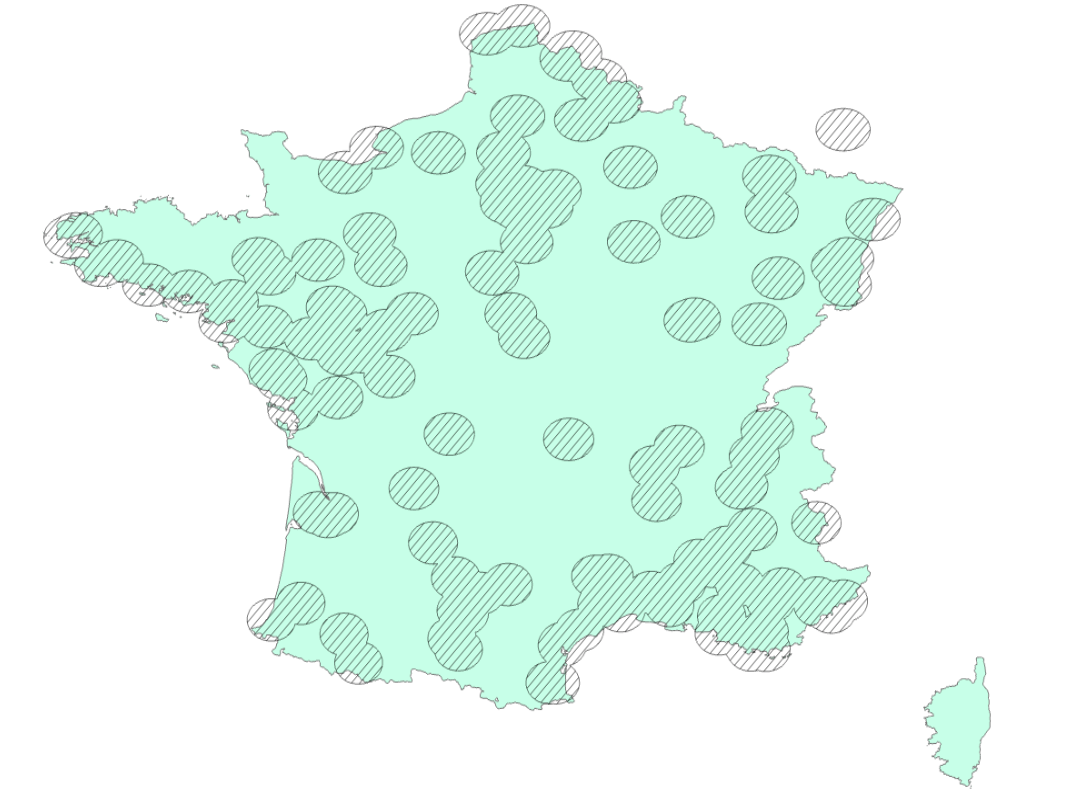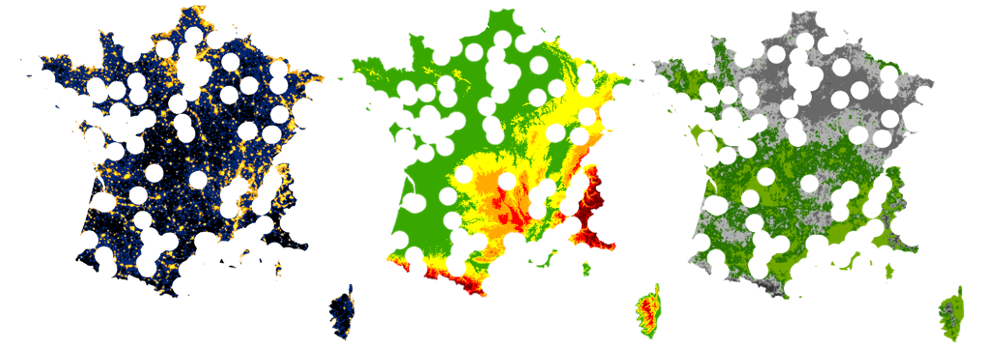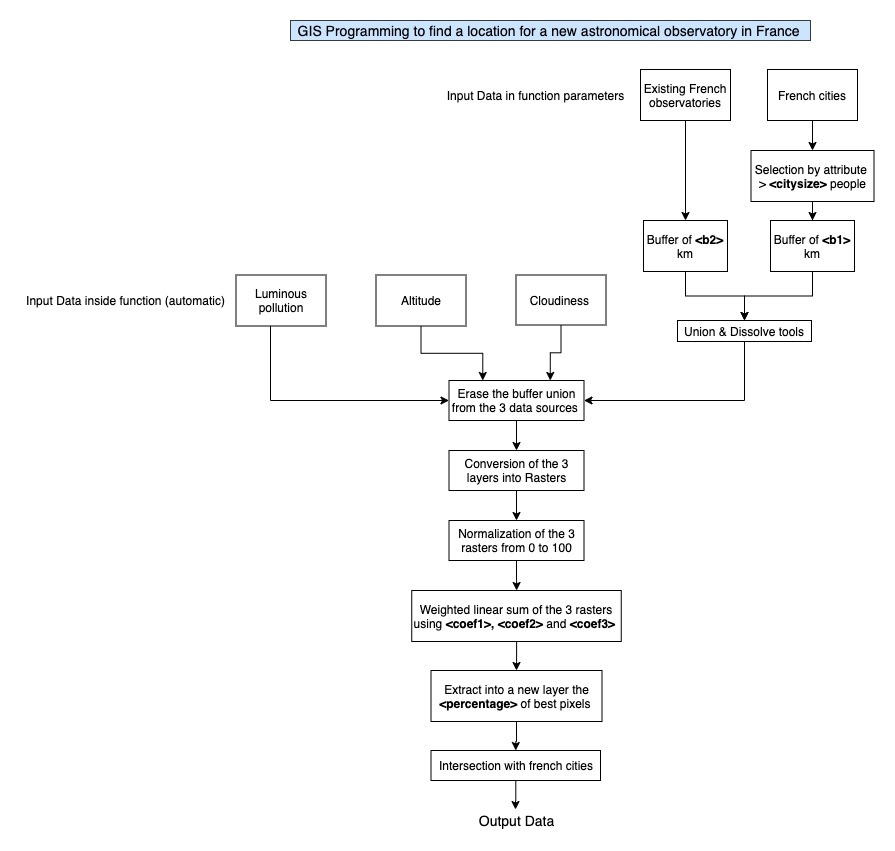FINAL VERSION:
- GIS Programming project to find a location for a new astronomical observatory in France
- 05/04/2020
- This project has been developed for the Geospatial Programming class of Spring 2020, an international collaboration between two universities, EPF of Sceaux, France and RUDN of Moscow, Russia.
- EPF : https://www.epf.fr/
- RUDN : http://www.rudn.ru
- Author : Maelle Sannier, EPF engineering student in 4th year, Aeronautics and Space major
- Instructor : Naci Dilekli, RUDN Professor, https://github.com/ndilekli/
DATA ARE FROM:
-
See data in Folder « Images »
-
Luminous Pollution and Cloudiness: Image and data processing by NOAA’s National Geophysical Data Center. MSP data collected by US Air Force Weather Agency. https://ngdc.noaa.gov/eog/dmsp/downloadV4composites.html#AVSLCFC
-
Altitude: Copernicus Land Monitoring Services https://land.copernicus.eu/imagery-in-situ/eu-dem/eu-dem-v1.1?tab=mapview
-
GPS coordinates of French cities: https://www.galichon.com/codesgeo/index.php
-
Number of people in French cities in 2017: INSEE https://www.insee.fr/fr/statistiques/4265429?sommaire=4265511
-
List of french observatories: Wikipedia & Google Maps
PURPOSE:
- This project can be used to find a location for a new astronomical observatory in France. It takes as inputs the Altitude in France, the Luminous pollution in France, the cities and their number of inhabitants, as well as the cloudiness in France, and the location of existing astronomical observatories in France.
HOW TO GET STARTED:
- Download the data under one and only folder that you will call « Observatories »
- Check that you do have a folder called « Results » that will host your results layers inside the Observatories folder
- Download ArcGIS if you do not have it already on your pc.
- Open Find_Observatories.ipynb and run it with your own parameters.
PARAMETERS:
- The user have to set as inputs inside the function parameters the following parameters
- workspace = storage space defined by the user e.g "C:/Observatories"
- b1 = Radius Buffer in Kilometers for 1rst feature class "30 Kilometers"
- b2 = Radius buffer in kilometers for 2nd feature class
- citysize = We want to avoid cities over inhabitants e.g <50000>
- coef1 = coefficient in the weighted sum for Crit1 e.g <3>
- coef2 = coefficient in the weighted sum for Crit2
- coef3 = coefficient in the weighted sum for Crit3
- percentage = percentage between 0 and 100 of best pixels of the weigthed sum layer that the user wants to keep e.g <10>
STEPS:
- Buffers are created around the existing observatories and the cities over
city size inhabitants.

- The buffers are united and erased from the 3 principal layers
(luminous pollution, altitude, cloudiness) of the study.

- The 3 layers are normalized from 0 to 100 and then summed with coefficients entered by the user in an arithmetic layer
- The user choose how much percentage of this layer he wants to keep. It means the best pixels will be extract in another layer (the pixels that will have the higher values --> the best places in France relatively to our criteria)
- This percentage is intersected with the frenchville (french cities) layer database.
- As a result the user will have one or a list of cities/villages, satisfying its criteria and that is able to host this new astronomical observatories.
QUICK VISUALIZATION:
USEFULNESS:
- Run the code with several parameters, one can choose the minimum size of the cities to avoid, as well as the sizes of the buffers around them and around the existing observatories. The GPS coordinates of the final cities will be given in output. One can run the code several times and this automatization is a lot faster than doing it on Arcmap. Moreover, one do not need to have any qualification on ArcGis to get a result.
——————————————————————————————————————
HOW TO GET HELP:
- Contact the author by electronic mail : maelle.sannier@epfedu.fr
WHO MAINTAINS AND CONTRIBUTES TO THE PROJECT:
- Contributor : Maelle Sannier
- The project will not be updated after the Final Version release.
